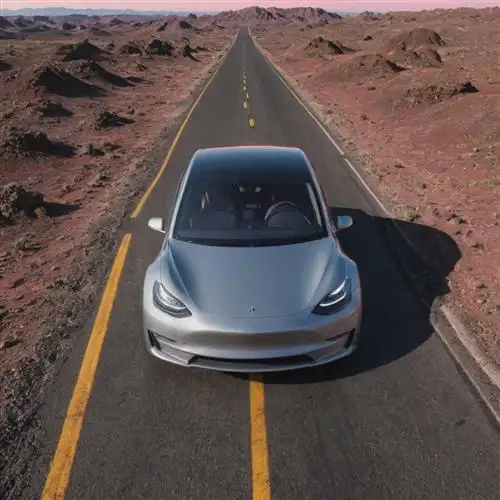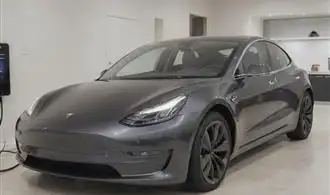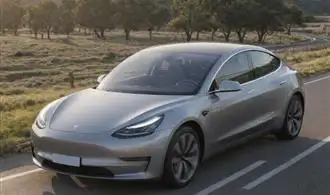
Upfront Cost and Potential Savings
When considering the Tesla Model 3, one of the key factors to weigh is the upfront cost and potential savings. The Model 3 is undoubtedly a premium electric vehicle, with pricing that reflects its technological advancements and performance capabilities. However, buyers should also factor in the long-term cost savings that come with owning an EV.
The base price of the Tesla Model 3 starts at around $43,990 for the Standard Range Plus variant. This might seem high compared to traditional internal combustion engine vehicles, but it's important to consider the various incentives and tax credits that can help offset the initial cost. For example, the federal government offers a tax credit of up to $7,500 for the purchase of a new electric vehicle, and many states and local municipalities offer additional incentives as well.
In terms of potential savings, owning a Tesla Model 3 can lead to significant reductions in fuel and maintenance costs. Electricity is generally much cheaper than gasoline, and the Model 3's electric motor requires less maintenance than a traditional gas-powered engine. Additionally, the Model 3's advanced regenerative braking system can help extend the life of the vehicle's brake pads and rotors, further reducing maintenance expenses.
Another factor to consider is the resale value of the Tesla Model 3. As a relatively new and highly sought-after electric vehicle, the Model 3 has shown strong resale value compared to many traditional cars. This can help offset the initial purchase price if you decide to sell the vehicle down the line.
Range and Charging Considerations
The Tesla Model 3's impressive range and efficient charging capabilities are two of the primary factors that draw many buyers to this electric vehicle. However, understanding the nuances of range and charging is crucial for making an informed decision. The Model 3 is available in different battery configurations, each with its own range and charging specifications.
The Standard Range Plus model boasts an EPA-estimated range of 263 miles, while the Long Range and Performance variants can travel up to 322 miles on a single charge. It's important to assess your daily driving needs and ensure the selected model's range aligns with your commute and lifestyle. Consider factors such as terrain, weather conditions, and driving habits, as they can impact the actual range you experience.
Charging the Model 3 is a straightforward process, but understanding the different charging options is essential. The vehicle comes equipped with a mobile charging cable that allows you to plug into a standard household outlet, providing a slow but convenient charging solution. For faster charging, Tesla's Supercharger network offers high-powered charging stations that can replenish the battery from 10% to 80% in as little as 30 minutes.
Additionally, Tesla provides the option to install a Wall Connector at your home or workplace, which can significantly reduce charging times. The Wall Connector can add up to 44 miles of range per hour, making it an efficient choice for overnight or workplace charging. It's worth noting that the cost and availability of Supercharger stations and home charging solutions may vary based on your location, so it's essential to research the charging infrastructure in your area.
Maintenance and Repair Costs
When it comes to owning a Tesla Model 3, the maintenance and repair costs are a crucial aspect to consider. Unlike traditional gasoline-powered vehicles, electric cars have a different set of requirements and considerations. As a prospective Tesla Model 3 owner, understanding these factors can help you make an informed decision and budget accordingly.
One of the primary advantages of the Tesla Model 3 is its relatively low maintenance needs. The electric motor requires less regular servicing compared to an internal combustion engine. There are no oil changes, spark plug replacements, or other related maintenance tasks typically associated with gasoline-powered cars. This can result in significant savings over the lifetime of the vehicle.
However, it's important to note that the specialized nature of electric vehicles, particularly the Tesla Model 3, can lead to higher repair costs in certain situations. The advanced technology and complex components, such as the battery pack and the electric drivetrain, may require specialized expertise and tools for diagnosis and repair. This can translate to higher labor costs at Tesla-authorized service centers or certified third-party mechanics.
Additionally, the cost of replacement parts for the Tesla Model 3 can be higher than traditional vehicles. The specialized nature of the components, as well as the limited availability, can contribute to these elevated costs. It's important to research and understand the potential replacement costs for key components, such as the battery pack, drive unit, and other high-value parts.
Another factor to consider is the availability of service and repair options. While Tesla has been expanding its network of service centers, there may be limited accessibility in some regions, particularly for owners living in remote or rural areas. This could result in the need for longer travel distances and potentially higher service costs due to transportation expenses.
To mitigate the potential impact of maintenance and repair costs, it's recommended to explore extended warranty options and Tesla's maintenance package offerings. These can provide additional peace of mind and coverage for unexpected repairs, helping to manage the overall ownership costs of the Tesla Model 3.
Environmental Impact and Sustainability
When considering the purchase of a Tesla Model 3, it's crucial to evaluate the vehicle's environmental impact and its contribution to sustainability. As an electric car, the Model 3 offers a significant advantage over traditional gasoline-powered vehicles in terms of reducing carbon emissions and mitigating the environmental consequences of transportation. However, it's important to delve deeper into the details to fully understand the car's environmental footprint.
One of the primary benefits of the Tesla Model 3 is its emissions-free operation. Unlike conventional vehicles that burn fossil fuels, the Model 3 produces no direct tailpipe emissions, making it a cleaner and more eco-friendly choice. This is particularly relevant in urban areas where air pollution is a significant concern. By opting for an electric vehicle like the Model 3, you can contribute to improving local air quality and reducing your personal carbon footprint.
Another important factor to consider is the source of the electricity that powers the Model 3. While electric vehicles are generally more environmentally friendly, the overall environmental impact can vary depending on the methods used to generate the electricity. In regions with a higher reliance on renewable energy sources, such as solar, wind, or hydropower, the Model 3's environmental benefits are even more pronounced. Conversely, in areas where the electricity grid is primarily powered by fossil fuels, the environmental advantages may be less significant. It's essential to research the local energy mix and understand the potential impact on the Model 3's sustainability.
The production and manufacturing of the Tesla Model 3 also play a role in its environmental impact. Tesla has made strides in improving the sustainability of its manufacturing processes, such as using renewable energy sources and implementing recycling and waste reduction initiatives. However, the production of lithium-ion batteries, which are a crucial component of electric vehicles, can have its own environmental implications, including the extraction and processing of raw materials. It's important to stay informed about Tesla's ongoing efforts to address these concerns and minimize the overall environmental impact of the Model 3's production.
Finally, the Tesla Model 3 Efficiency - Things I Wish I Had Known Sooner is an important consideration when evaluating the car's environmental impact. The Model 3's impressive energy efficiency, combined with its ability to regenerate energy through braking, contributes to its overall sustainability. By maximizing the car's efficiency, you can further reduce your energy consumption and carbon footprint during your daily commute or road trips.
Autopilot and Advanced Safety Features
Autopilot and Advanced Safety Features
The Tesla Model 3 is renowned for its advanced Autopilot capabilities, which go beyond mere driver assistance to offer a comprehensive suite of intelligent safety features. At the core of this system is a robust array of sensors, including cameras, radar, and ultrasonic sensors, that work together to provide a 360-degree awareness of the vehicle's surroundings. This sophisticated technology allows the Model 3 to automatically adjust speed, maintain lane positioning, and even change lanes with the simple push of a turn signal.
One of the standout features of the Tesla Autopilot is its ability to anticipate and respond to potential hazards on the road. The system can detect pedestrians, cyclists, and other vehicles, and it will alert the driver and apply the brakes if a collision is imminent. This can be particularly valuable in emergency situations, where a mere fraction of a second can mean the difference between a near-miss and a serious accident.
In addition to the standard Autopilot features, the Tesla Model 3 also offers a range of advanced safety technologies that can further enhance the driving experience. The vehicle's Automatic Emergency Braking (AEB) system, for instance, can detect impending collisions and apply the brakes automatically to mitigate the impact. The Lane Departure Avoidance feature, on the other hand, can gently steer the car back into the lane if it detects the vehicle drifting across the line.
Perhaps one of the most impressive aspects of the Tesla Autopilot is its ability to learn and adapt over time. The system constantly receives software updates, which can introduce new capabilities or refine existing ones. This means that the Autopilot experience in a Tesla Model 3 today may be significantly different from what it was a year ago, or even a few months ago. As the technology continues to evolve, the safety and convenience of Autopilot are likely to become even more impressive.
Resale Value and Depreciation
When it comes to the Tesla Model 3, resale value and depreciation are critical factors to consider. Tesla's vehicles are known for their advanced technology, eco-friendly design, and impressive performance, but these attributes also contribute to a unique depreciation curve compared to traditional internal combustion engine vehicles.
The Tesla Model 3 tends to hold its value better than many other luxury cars, especially in the first few years of ownership. This is largely due to the ongoing demand for Tesla vehicles and the perceived scarcity of the brand's products. However, it's important to note that the resale value can fluctuate based on various factors, including battery capacity, software updates, and the overall condition of the vehicle.
One key consideration is the impact of software updates on the Tesla Model 3's value. Tesla regularly releases over-the-air software updates that can enhance the vehicle's performance, range, and features. These updates can significantly impact the perceived value of the car, as they effectively "upgrade" the vehicle without the need for major hardware changes.
Additionally, the Tesla Model 3's battery capacity and charging capabilities play a crucial role in resale value. As battery technology continues to improve, the range and charging speed of newer Tesla models may surpass older versions, potentially impacting the value of used vehicles. Buyers may be willing to pay a premium for a Model 3 with the latest battery technology and charging capabilities.
It's also important to consider the overall condition of the Tesla Model 3 when evaluating its resale value. Regular maintenance, proper care, and any instances of damage or accidents can all affect the perceived value of the vehicle. Buyers may be hesitant to purchase a used Model 3 with a history of significant repairs or modifications.
To maximize the resale value of a Tesla Model 3, owners should consider the following:
- Regularly maintaining the vehicle and keeping it in excellent condition
- Staying up-to-date with software updates to ensure the car's features and performance remain competitive
- Monitoring the battery capacity and charging capabilities, as newer models may offer improved range and charging speed
- Keeping detailed records of the vehicle's history, including maintenance, repairs, and any modifications
Tesla Ecosystem and Integration
The Tesla Ecosystem and Integration is a crucial aspect to consider when purchasing a Tesla Model 3. Tesla has built a comprehensive suite of products and services that work seamlessly together, providing a unique and tailored experience for its customers. Understanding the depth and breadth of this ecosystem can significantly enhance the ownership experience and unlock additional value.
At the heart of the Tesla ecosystem is the Tesla app, which serves as the central hub for managing various aspects of your vehicle. Through the app, you can access a wealth of information, including the current charge level, range, and even the ability to remotely control various functions, such as climate settings, door locks, and the ability to summon your vehicle. This level of connectivity and control can simplify your daily driving experience and provide a sense of convenience that is unparalleled in the automotive industry.
Beyond the Tesla app, the ecosystem extends to the company's expansive network of Supercharger stations, which are strategically placed throughout the world to provide reliable and efficient charging for Tesla owners. The Supercharger network not only ensures that you can easily recharge your vehicle during long-distance travels, but it also offers a seamless and consistent charging experience, with the ability to add significant range in a matter of minutes.
Another key component of the Tesla ecosystem is the company's energy products, including the Powerwall and solar panel offerings. These integrated solutions allow Tesla owners to generate, store, and manage their own energy, potentially reducing their reliance on the traditional grid and aligning with the brand's sustainable and environmentally-conscious ethos. By leveraging these energy products, Tesla owners can further enhance the overall efficiency and cost-effectiveness of their driving experience.
Furthermore, the Tesla ecosystem extends to the company's software updates, which are delivered over-the-air (OTA) to continuously improve the performance, safety, and functionality of the vehicle. This means that your Tesla Model 3 can become even more capable and advanced over time, without the need for extensive dealership visits or physical modifications. This level of ongoing innovation and improvement is a testament to Tesla's commitment to its customers and the long-term value of its vehicles.


















